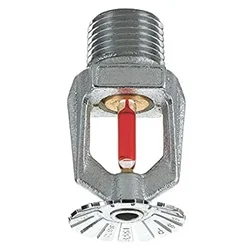- Farm & Garden
- Pumps & Motors
- Food Processing
- Workshop, DIY & MRO
- Lab & Measuring Tools
Brand : Generic ( Made in India )
Sense Safety Fire Sprinkler Pendent Type 68 Degree- Brass & Chrome, Ceiling Mounted Fire Fighting Equipment ( pack of 2 )
SKU : TI-SS-27321
MRP : ₹500
₹385
23% OFF!
-
1
+
 Delivery By: Nov 9 - Nov 11
Delivery By: Nov 9 - Nov 11 
Easy Return
& Refund
& Refund

Quality
Assurance
Assurance

Trusted
Delivery
Delivery

After Sales
Assistance
Assistance

Buyer
Protection
Protection
Short Description
A fire sprinkler is a crucial fire protection device designed to automatically detect and suppress fires in buildings.
Country of origin: India
- Brand: Generic ( Made in India )
- Weight (Approx.) : 500 gm
- Product Dimensions 1.27 x 1.27 x 1.27 cm
- MOC:-GUN METAL OPERATION
- OPERATION TEMPERATURE :- 68°C / 155°F , SPRINKLER THREADING
- SIZE 1/2" (12.7 mm)
- USED FOR FIRE FIGHTING PURPOSE
Fire Sprinkler System is designed to provide reliable and effective fire protection for residential, commercial, and industrial spaces. Engineered with advanced technology and high-quality materials, this system ensures rapid response to fire outbreaks, minimizing damage and enhancing safety for occupants.
Features
:- Fire sprinklers are equipped with heat-sensitive elements (such as glass bulbs or fusible links) that activate when exposed to high temperatures, typically around 155°F to 200°F (68°C to 93°C), allowing for rapid response to fire.
- Sprinklers are designed to distribute water evenly over a designated area, effectively suppressing flames and cooling hot surfaces to prevent fire spread.
- Available in various styles, including pendant, upright, sidewall, and concealed designs, allowing for aesthetic integration into different environments.
- Many fire sprinklers are made from corrosion-resistant materials, such as stainless steel or specially coated metals, ensuring durability and longevity in various conditions.
- Sprinklers can be configured to provide specific coverage areas based on the layout of the space, ensuring that all critical areas are protected.
- Fire sprinkler systems can be designed with zoning options, allowing for targeted activation in specific areas of a building, which can help conserve water and minimize damage.
- Fire sprinklers require minimal maintenance, with periodic inspections and testing to ensure functionality, making them a cost-effective fire protection solution.
- Fire sprinklers primarily use water as an extinguishing agent, making them an environmentally friendly option compared to chemical-based suppression systems.
- Fire sprinklers are designed to meet or exceed local and national safety codes and standards, such as those set by the National Fire Protection Association (NFPA).
Applications
:1. Residential Protection:
Home Safety: Installed in homes to protect occupants and property from fire hazards, especially in high-risk areas like kitchens and garages.
Insurance Benefits: Many insurance companies offer discounts for homes equipped with fire sprinkler systems, as they significantly reduce fire damage.
2. Commercial Buildings:
Office Spaces: Protects employees and assets in office environments, ensuring business continuity in case of a fire.
Retail Stores: Safeguards merchandise and provides a safe environment for customers and staff.
3. Industrial Facilities:
Manufacturing Plants: Protects machinery, raw materials, and finished products from fire, which can be particularly critical in facilities that handle flammable materials.
Warehouses: Reduces the risk of fire spreading through large storage areas, protecting inventory and equipment.
4. Educational Institutions:
Schools and Universities: Ensures the safety of students and staff, providing a quick response to potential fire incidents in classrooms, laboratories, and dormitories.
5. Healthcare Facilities:
Hospitals and Clinics: Protects patients, staff, and sensitive medical equipment, ensuring that fire emergencies are managed effectively without compromising patient care.
6. Hotels and Hospitality:
Guest Safety: Provides a safe environment for guests in hotels, motels, and resorts, helping to protect lives and property.
7. Public Buildings:
Government Offices: Ensures the safety of employees and the public in government buildings, including courthouses and municipal offices.
Libraries and Museums: Protects valuable collections and artifacts from fire damage.
8. Transportation Facilities:
Airports and Train Stations: Provides fire protection in high-traffic areas where large numbers of people gather, ensuring safety during travel.
9. Data Centers:
IT Infrastructure Protection: Safeguards critical IT equipment and data from fire, which can lead to significant financial losses and data breaches.
10. Agricultural Facilities:
Barns and Storage: Protects livestock and stored agricultural products from fire hazards, which can be particularly devastating in rural areas.
11. High-Rise Buildings:
Multi-Story Safety: Essential for high-rise buildings where evacuation can be challenging; sprinklers help control fires until emergency services arrive.
12. Special Hazards:
Chemical Storage Facilities: Specialized sprinkler systems can be designed to protect areas where flammable or hazardous materials are stored.
Select attribute





